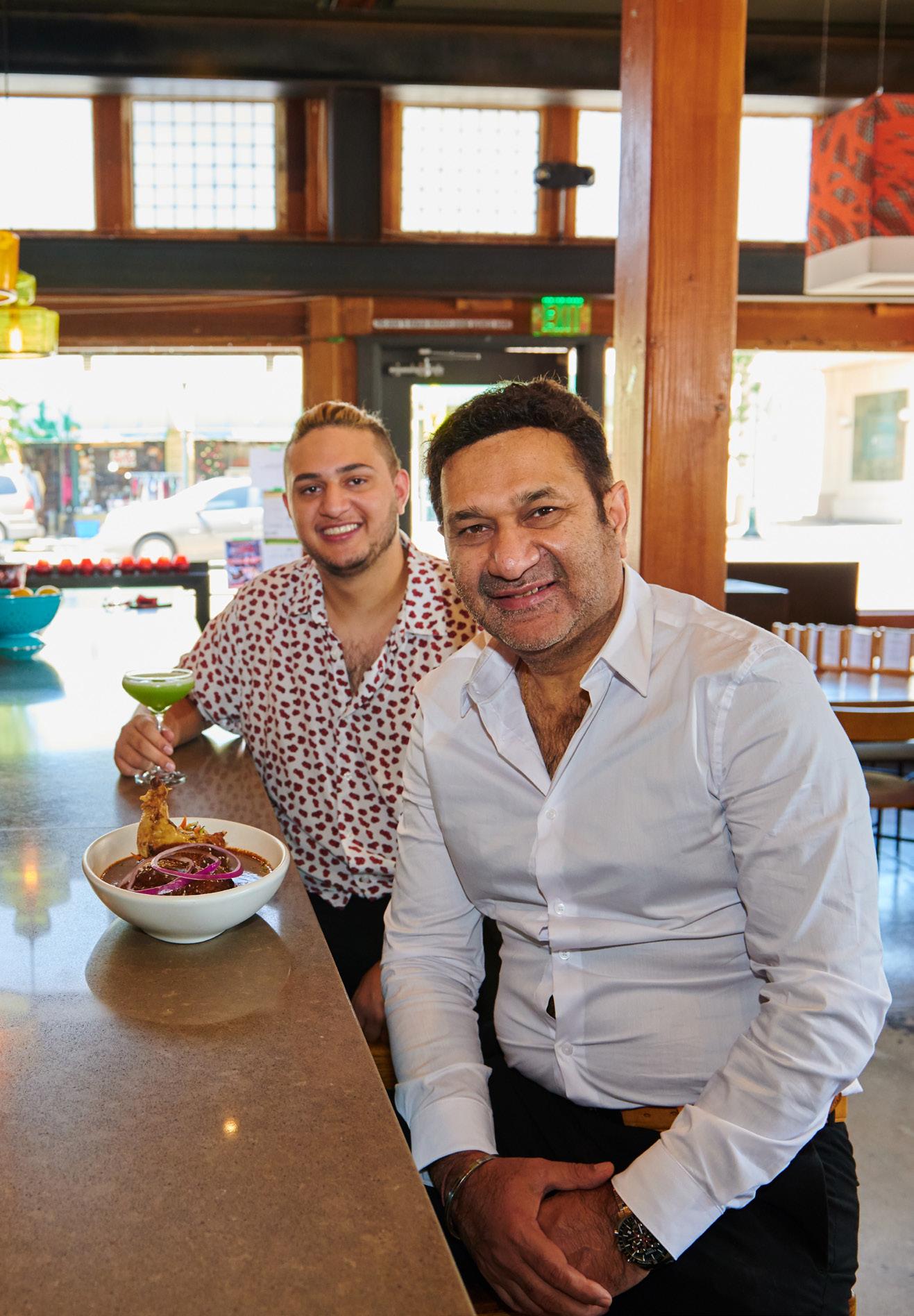
8 minute read
KARAN RAINA
from August Arroyo 2020

Karan
Raina
THE FOOD ARTIST IN SOUTH PASADENA BY NIKHIL BHAMBRI
South Pasadena residents take pride in its peace, tranquility, neighborhood parks and high-quality schools.
By and large, South Pasadena residents are happy to leave the dining and nightlife hubbub to Old Town Pasadena and Alhambra’s Main Street. However, in the last few years, an eclectic collection of restaurants and bars have sprung up on Mission Street.
This new chapter began slowly when the Metro Stop opened and city leaders started to refurbish Mission Street. It accelerated in 2010 with the arrival of one bold restauranteur who was determined to test his luck in South Pasadena. The man’s suc- cess paved the way for other entrepreneurs. Today, the city’s original business district along Mission and El Centro streets is reclaiming its past glory as “Old Town” South Pasadena. The man behind the bustling energy is the enterprising, out-of-the-box thinker Karan Raina.
Karan’s business success stems from his eagerness to constantly reinvent him- self and his cooking style. His knack for understanding customers has allowed him to expand the culinary horizon of South Pasadena residents while fostering their sense of small-town community.
“When you stay in a luxury Indian hotel, you do not need to go anywhere; every- thing is provided in the hotel,” he says about previous training.
“If you want something, they will provide it even if it is not on the menu. You tell them what you want; they will do whatever they need to do to try and get it for you.”
Karan brings this attitude of doing anything possible to unite South Pasadena resi- dents around a shared love of food.
Originally from New Delhi, Karan entered the restaurant business in 1995 when he opened Radhika Modern Indian in Alhambra. He soon relocated to Pasadena but had to shut the restaurant when his lease ran out in 2008. Two years later, in 2010, Karan opened Radhika Modern Indian at 966 Mission Street, South Pasadena.
Most people discouraged Karan from opening his restaurant in South Pasadena because of the city’s relative lack of commercial activity. At that time, Mission Street had very little retail action except for a few family-owned antique stores.
“This area was not looked at as a forward-moving kind of vibe,” says Kiran, Karan’s son. “No businesses were looking to jump here and invest a lot of money in starting a project, let alone a family, high-end restaurant.”
Karan pioneered in bringing a full-service restaurant to the block, ultimately caus- ing a restaurant ecosystem to gain momentum.
“Now more restaurants want to come and get a piece of the pie,” Kiran says. A few years later, Griffin’s of Kinsdale, Simplee Boba, Bluefin Sushi and Roll, and La Monarca Bakery and Cafe opened on the same block.
Radhika is housed in the historic Mission Arroyo Hotel. Inside, remnants of India come in contact with Los Angeles’ trendy, hipster culture.
“Because my audience is all contemporary Southern Californian, I want to create a SoCal ambiance,” Karan says.
“I do not want to overly clam things up with ethnic murals.”
The blue painted walls, decorated with wine bottles, Indian paintings and artifacts, surround the smell of Indian spices and racy Bhangra/Bollywood music. Modern-look- ing blue-and-red-striped lamps hang from the ceiling.
The vibe is completely different from most Indian restaurants where customers feel they have been transported to a Mughal Court or ancient temple in India.
“India has a lot more than the Taj Mahal; there are many deeper layers, such as the cuisine,” Karan says.
“Our decoration is not in-your-face Indian art. Instead, you see a subtle but often underappreciated aspect of Indian life, and we do it just to create the ambiance.”
For example, the cloths on the sofas contain old Rajasthani-style icons, while the walls display photographs of Indian street shops.
In his new location, Karan wanted to create something different by bringing out new elements and style in Indian food. South Pasadena’s largely non-Indian demographic provided the perfect opportunity. Radhika represents a culinary merger of East and West, serving traditional Indian dishes and Latino and Continental delicacies cooked with exotic Indian spices. Nontraditional dishes include Punjabi chicken tacos, paella, shrimp tostada, baby back ribs, lamb shank and Brussels sprouts. The innovative menu allows South Pasadena’s population to eat “comfort American food” while simultaneously enjoying flavorful Indian spices.
However, Karan defines his food as modern, not fusion. Everything is cooked only with Indian spices and ingredients. For example, the Punjabi taco contains no Mexican spices. It just looks like a taco, yet everything inside is Indian.
“Fusion equals confusion,” Karan says, and contends that using foreign ingredients would not make his food authentically Indian.
Nick Vyas, a long-term South Pasadena resident and Karan’s friend, considers Radhika a great local asset. Vyas claims Radhika is the only restaurant where he will eat Indian food, because “the quality is as good as it is at home.”
Before Radhika, Vyas frequented Old Town Pasadena, but now he avoids the hassle of driving and parking by enjoying his evening in South Pasadena, where parking is more accessible.
In 2014, Karan and his Salvadorian wife, Candy Garcia-Raina, opened ARO Latin, a tequila mezcal bar, across the street from Radhika. Until 2 a.m., the bar is hopping with residents enjoying a drink and late-night snack with their fellow neighbors. The menu serves a wide selection of alcohol and food from Central, South America and Mexico. ARO engages the community by hosting various themed events often featuring live DJs. Some of these include celebrations for New Year’s Eve, Day of the Dead, Wine Wednesday and Margarita Mondays.
Bartender Alejandro Chavez lights up ARO with his positive energy and cultivates a personal connection with his clientele. Chavez believes Karan’s presence in South Pasadena has given the town a multicultural identity.
“California is one of the most multicultural states, so it is healthy for the community to have businesses that reflect that.”
Many of the neighborhood’s residents may have never discovered Indian or Latin cuisine if Radhika and ARO had not come to their backyard.
Although well established on Mission Street, Karan still contemplates other ways to bring his passion for food to South Pasadena. He currently plans to start a food truck or stall that would serve Indian-style street food, where customers pick from a variety of ingredients on display that are then assembled and cooked to order very quickly. It is an interactive, immersive experience, reminiscent of the scene in every Indian city.
During these turbulent times of post-COVID opening, Karan plans to modify his menu at Radhika and ARO. He predicts that his clientele will become more health conscious and plans to offer more vegetarian and vegan food items. At ARO, he will install a small herb garden on the restaurant’s outside wall to provide fresh herbs for garnishes and cocktails.
Peter Giulioni, a longtime South Pasadena resident, is impressed with Karan’s endeavors.
“Karan is a very good restaurateur, and it is reflected in the quality of the service and food,” Giulioni says. “Radhika is a delightful restaurant. Food is good, service is solid, prices are reasonable. When ARO opened we were immediately drawn to it. The vibe in there is phenomenal. (Karan) has made himself a South Pasadena institution. He has done a great job of making people like myself cross Fremont Ave on Mission. He has really served as an anchor for that area to flourish.”
Karan says that his entrepreneurial success would not be possible without the city’s continued support.
“South Pasadena has been extremely supportive bout what my dad has been doing here,” Kiran says. “Big shout out to the mayor and council members. They are very important to this whole thing.”
Karan feels South Pasadena has welcomed him with open arms and provided opportunities for him to bond with the community. Looking back to his decade as a restaurateur on Mission Street, he reflects on how frequently he has catered at the many events hosted by South Pasadena Educational Foundation.
“South Pasadena businesses that survive have an interpersonal relationship with the community,” Chavez adds. “Radhika and ARO have had a lot of regulars who look forward to coming and have been following us since the beginning. Community support for both restaurants is very strong.”


RADHIKA MODERN INDIAN
966 Mission Street, South Pasadena 626-799-2200, radhikarestaurant.com
ARO LATIN
In the previous installments of this design series, we discussed using the concept of Form Following Function to begin conceiving your design and how to direct the visual journey with the use of void and masses.


In this article, we will discuss using line and focus to enhance the aesthetics of your yard’s function and further direct the eye to visually important elements with some artistic flare.
The illustration above is a take on an actual project Garden View completed. As you can see from the drawing and picture, there is a path that leads physically and visually to the point of interest—the statue with a functional seating area. The lines are bold, distinct and symmetrical, the visual journey is highlighted by the fact that the path and low plants next to it are voids (low and not obstructing a view) that are framed by masses of tallerprofile plants. In doing so, we are creating curved-yet-direct lines, subliminally drawing the viewer more strongly toward the point of interest.
The lines in this concept do not all need to be orderly, sharp or symmetrical. A row of lights, a line of trees/shrubs, lawns or annual color beds can be used to direct line of sight. A few of our other favorites like streams, stepping stones, hedges and stone walls can also be used to accomplish this effect as well. Have fun, use your imagination and take inspiration from projects and artists you admire.
In our next article, we will explore a deeper level of detail with how to use textures in your landscape.








